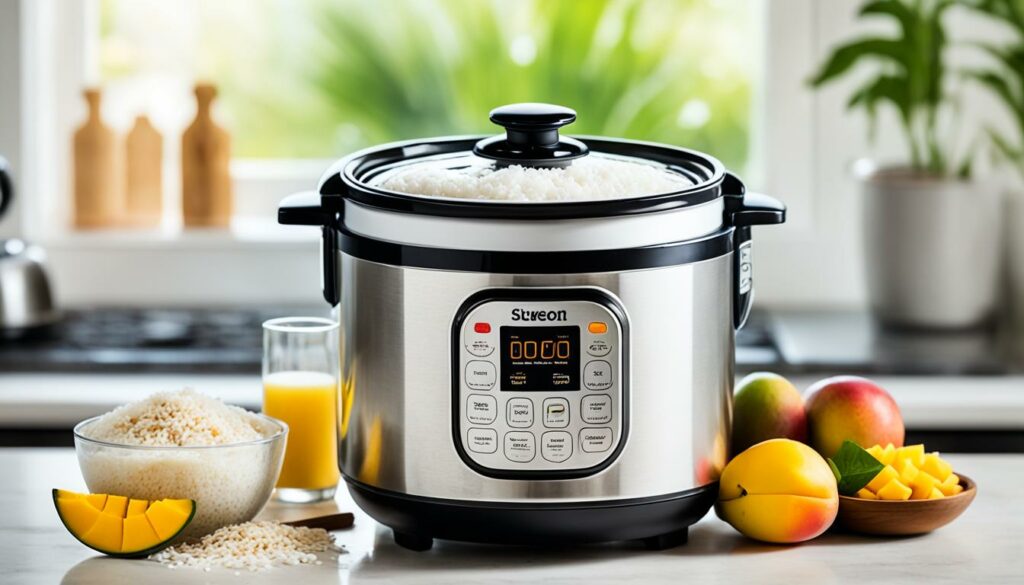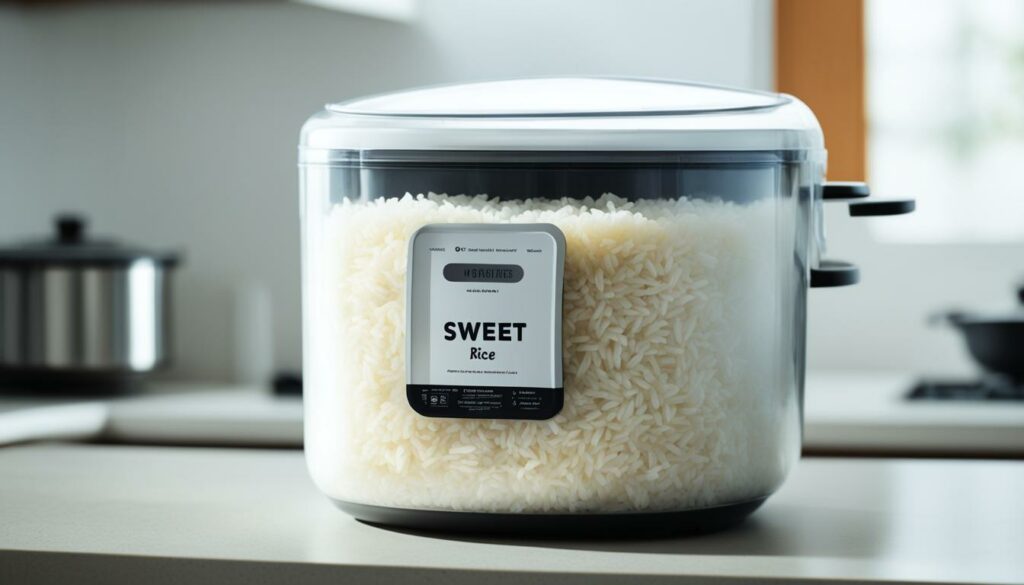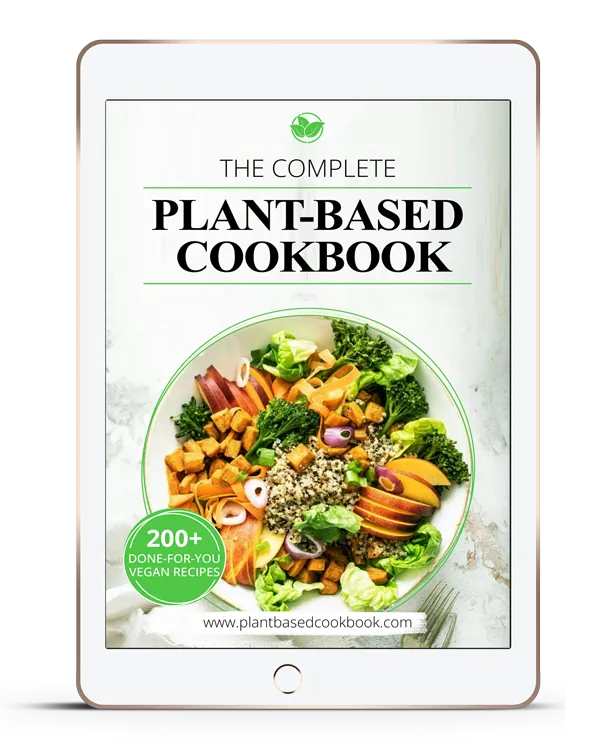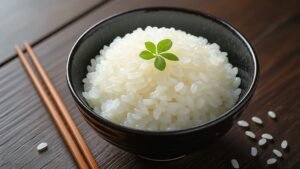Imagine this: It’s a warm summer evening, and you’re craving a sweet and sticky treat. You decide to make a delicious sweet rice dessert, but the thought of standing over a hot stove and constantly stirring is daunting. That’s where a rice cooker comes to the rescue!
A rice cooker is a versatile kitchen appliance that can do so much more than just cook rice. It’s the secret weapon for effortlessly creating perfectly cooked sweet rice every time. Whether you’re a seasoned chef or a beginner in the kitchen, cooking sweet rice in a rice cooker is a simple and foolproof method that guarantees incredible results.
In this article, we will guide you through the process of cooking sweet rice in a rice cooker. We’ll share easy sweet rice recipes, cooking tips, and the best practices for achieving that irresistibly sticky texture and delightful sweetness. Say goodbye to the guesswork and hello to the most delicious sweet rice dishes you’ve ever tasted!
Table of Contents
ToggleKey Takeaways:
- Learn how to cook sweet rice in a rice cooker with ease
- Discover mouthwatering sweet rice recipes for both dessert and savory dishes
- Get expert tips on achieving the perfect texture and flavor in your sweet rice
- Master the art of storing and reheating sweet rice to maintain its quality
- Embrace the joy of cooking sweet rice and savor the delectable results
Understanding Sweet Rice Varieties
Sweet rice, also known as glutinous rice, is a type of rice that becomes sticky and chewy when cooked. It is the main ingredient in many traditional Asian dishes, including rice dumplings and sticky rice desserts. There are different varieties of sweet rice, including white glutinous rice and black glutinous rice.
What Is Sweet Rice?
Sweet rice, also known as glutinous rice, is a type of rice that has a higher starch content compared to regular rice. When cooked, the starch in sweet rice becomes gelatinous, resulting in a sticky and chewy texture. This unique characteristic makes it a popular choice for various Asian dishes, especially desserts.
The Glutinous Difference in Sweet Rice
The term “glutinous” used to describe sweet rice can be misleading, as it does not contain gluten. The word “glutinous” refers to the sticky texture of the rice when cooked. Sweet rice gets its stickiness from the high amylopectin content in its starch, which gives it a unique chewy texture.
White vs. Black Glutinous Rice
White glutinous rice is the most common variety of sweet rice. It is often used in both savory and sweet dishes, including rice cakes, sushi rolls, and coconut sticky rice. White glutinous rice has a neutral flavor and a slightly sweet taste.
Black glutinous rice, on the other hand, has a darker color and a nuttier flavor. It is often used in desserts and is a popular ingredient in dishes such as black sticky rice pudding and black rice porridge. Black glutinous rice is rich in antioxidants and has a more distinctive appearance compared to white glutinous rice.
To better understand the differences between white and black glutinous rice, refer to the table below:
| White Glutinous Rice | Black Glutinous Rice |
|---|---|
| Most common variety | Distinctive appearance |
| Neutral flavor | Nuttier flavor |
| Slightly sweet taste | Rich in antioxidants |
Understanding the different varieties of sweet rice will help you choose the right type for your recipe, whether you’re looking to create a savory Asian dish or a delectable sweet dessert.
How to Cook Sweet Rice in a Rice Cooker
Cooking sweet rice in a rice cooker is a simple and straightforward process that guarantees consistently perfect results. With a rice cooker, you can eliminate the need for complicated soaking or steaming methods. In this section, we will guide you through the step-by-step process of cooking sweet rice in a rice cooker, ensuring that you achieve the best texture and flavor.
Before starting, make sure you have the following ingredients:
- Sweet rice
- Water
- Salt (optional)
Now, let’s get started:
- Wash and rinse the sweet rice under cold water until the water runs clear. This helps remove any excess starch and ensures a better texture in the cooked rice.
- Transfer the washed sweet rice into the rice cooker pot.
- Add water to the rice cooker pot, using the recommended water-to-rice ratio of 1:1. For example, if you are cooking 1 cup of sweet rice, add 1 cup of water.
- Add a pinch of salt to enhance the flavor of the sweet rice (optional).
- Close the rice cooker lid and select the “Sweet Rice” or “Glutinous Rice” setting. If your rice cooker doesn’t have specific settings, simply select the regular rice cooking mode.
- Press the start button to begin cooking.
Your rice cooker will automatically cook the sweet rice and switch to the keep warm function once it’s done. Let the sweet rice sit in the rice cooker for about 10 minutes to allow the steam to redistribute and the rice to fully absorb any remaining moisture.
Once the sweet rice has rested, open the rice cooker lid and fluff the rice gently with a fork or rice spatula. Serve the deliciously cooked sweet rice as a side dish, dessert, or incorporate it into your favorite recipes.
With these simple steps, you can easily cook sweet rice in a rice cooker. It’s a convenient and foolproof method that ensures you enjoy perfectly cooked sweet rice every time. Experiment with different recipes and flavors to create delightful dishes using your rice cooker sweet rice. Now, let’s move on to the next section for more tips and tricks.
Preparing Your Rice Cooker for Sweet Rice
Properly preparing your rice cooker is essential for cooking sweet rice to perfection. Follow these steps to ensure optimal results:
Choosing the Right Equipment
When selecting a rice cooker for sweet rice, consider the following factors:
- Capacity: Choose a rice cooker that can accommodate the quantity of sweet rice you intend to cook.
- Cooking Settings: Look for a rice cooker with specific settings for sweet rice or sticky rice. These settings optimize the cooking process for the best texture and flavor.
- Brand and Reviews: Research different rice cooker brands and read customer reviews to ensure you choose a reliable and high-quality product.
By carefully selecting the right rice cooker, you can ensure that it meets your specific sweet rice cooking needs.
Setting Up Your Rice Cooker for Optimal Cooking
Once you’ve chosen the right rice cooker, it’s important to set it up correctly:
- Place the inner pot into the rice cooker and make sure it is clean and dry.
- Add the desired amount of sweet rice to the pot and rinse it thoroughly under cold water to remove excess starch.
- Drain the rinsed rice and add the appropriate amount of water according to the recipe or the rice cooker’s instructions.
- Close the lid securely and plug in the rice cooker.
- Depending on your rice cooker model, select the sweet rice or sticky rice cooking setting.
- Press the start button to begin the cooking process.
Following these steps will ensure that your rice cooker is properly set up for optimal cooking of sweet rice, producing deliciously sticky and flavorful results.
The Perfect Water-to-Rice Ratio for Sweet Rice
Achieving the perfect water-to-rice ratio is crucial for cooking sweet rice in a rice cooker. The amount of water used can greatly affect the texture and consistency of the cooked rice. Measuring your ingredients accurately is essential to ensure the best results.
Measuring Your Ingredients Accurately
- Use a measuring cup specifically designed for rice to ensure accurate measurements. Regular measuring cups may not provide the same level of accuracy.
- For sweet rice, the general rule of thumb is to use a 1:1.25 water-to-rice ratio. This means that for every cup of sweet rice, you should use 1.25 cups of water. However, this ratio may vary slightly depending on personal preference and the specific type of sweet rice being used.
- Be sure to level off the measurement when measuring both the rice and water to ensure consistency.
- If the rice turns out too dry, try increasing the amount of water slightly. Conversely, if the rice is too sticky or mushy, reduce the amount of water in the recipe.
Servings and Adjustments
The serving size for sweet rice can vary depending on the recipe and personal preference. As a general guideline, one cup of uncooked sweet rice typically yields about three to four servings. However, you can adjust the recipe based on your desired number of servings.
When adjusting the recipe for different serving sizes, remember to maintain the proper water-to-rice ratio. For example, if you want to double the recipe, use twice the amount of rice and water while keeping the ratio consistent.
| Servings | Sweet Rice (cups) | Water (cups) |
|---|---|---|
| 2 | 1 | 1.25 |
| 4 | 2 | 2.5 |
| 6 | 3 | 3.75 |
| 8 | 4 | 5 |
Table: Water-to-Rice Ratio for Sweet Rice
Using the correct water-to-rice ratio and accurately measuring your ingredients will help you achieve perfectly cooked sweet rice in your rice cooker. Experiment with different adjustments and serving sizes to find the perfect balance for your tastes and preferences.
Rinsing and Soaking Sweet Rice
Rinsing and soaking sweet rice before cooking is an important step that helps remove excess starch and ensures a better texture in the cooked rice. By following the proper rinsing and soaking techniques, you can enhance the overall quality of your sweet rice dishes.
To begin, rinse the sweet rice under cold running water in a fine-mesh sieve. Gently swish the rice with your fingers to remove any dirt or impurities. Repeat this process until the water runs clear, indicating that most of the starch has been removed.
After rinsing, transfer the sweet rice to a bowl and add enough water to cover the rice completely. Let the rice soak for at least 30 minutes or up to overnight, depending on your preference and the recipe requirements. Soaking the rice allows it to absorb moisture, resulting in a more tender and evenly cooked final dish.
During the soaking process, the rice grains will become plump and slightly translucent. This is a sign that the rice is ready for cooking. Ensure that the rice is fully submerged in water throughout the soaking duration to promote even hydration.
Soaking sweet rice not only improves the texture but also helps shorten the cooking time. The hydrated grains cook more evenly and require less time to become tender. This step is particularly crucial when using a rice cooker to ensure optimal results.
Now that you have learned how to properly rinse and soak sweet rice, you are ready to proceed with the cooking process. The next section will guide you through the steps of cooking sweet rice in a rice cooker, including setting up your rice cooker and achieving the ideal water-to-rice ratio for the perfect batch of sweet rice.
Cooking and Timing for The Perfect Sweet Rice
Cooking sweet rice to perfection requires proper timing and techniques. To ensure that your sweet rice turns out perfectly fluffy and delicious, follow the steps below.
Starting the Cooking Process
Once you have prepared your sweet rice, it’s time to start the cooking process. Place the rinsed and soaked sweet rice in the rice cooker and add the appropriate amount of water according to the recommended water-to-rice ratio. Close the lid of the rice cooker and select the sweet rice cooking setting, if available.

When to Fluff and Rest Your Sweet Rice
After the cooking cycle is complete, it’s important to let the sweet rice rest for a few minutes. This resting period allows the rice to fully absorb any remaining moisture and results in a more uniform texture. Keep the rice cooker closed during this time to trap the steam and ensure even distribution.
Once the resting period is over, gently fluff the sweet rice with a fork or rice paddle. This helps to separate the grains and gives the rice a light and fluffy texture. Be careful not to overmix or stir vigorously, as this can make the sweet rice mushy.
Now that you have successfully cooked and fluffed your sweet rice, it is ready to be enjoyed as a delicious side dish or incorporated into your favorite sweet or savory recipes.
Delicious Sweet Rice Recipe Ideas
Sweet rice, also known as glutinous rice, is a versatile ingredient that can be used to create a wide range of delicious dishes. In this section, we will share some mouthwatering sweet rice recipe ideas that are sure to satisfy your cravings. Whether you’re looking for a sweet dessert or a savory treat, sweet rice can be the star ingredient in your culinary creations.
Sweet Rice for Dessert Dishes
When it comes to dessert, sweet rice takes center stage in many traditional Asian recipes. From sticky rice pudding to mango sticky rice, there are endless possibilities to explore. The natural sweetness and sticky texture of the rice make it a perfect base for creamy and indulgent desserts.
One popular dessert dish with sweet rice is the Japanese dish Mochi. Mochi is a soft and chewy rice cake made with sweet rice flour. It can be filled with various flavors, such as red bean paste or matcha. Another delicious sweet rice dessert is the Thai dish Khao Niaow Ma Muang, which consists of sticky rice topped with fresh mango slices and coconut cream.
For a twist on the traditional, you can also experiment with unique flavors and ingredients. Consider adding fruits like strawberries or blueberries to your sweet rice pudding for a burst of freshness. Alternatively, drizzle your sticky rice with a rich caramel sauce for an extra touch of decadence.
Savory Sweet Rice Combinations
While sweet rice is often associated with desserts, it can also be used to create savory dishes that are equally delicious. The natural sweetness of the rice adds a unique flavor profile to savory combinations, creating a perfect balance of taste.
One popular savory dish with sweet rice is the Korean dish Bibimbap. Bibimbap is a rice bowl topped with an assortment of vegetables, meat, and a fried egg. By using sweet rice instead of regular rice, you can add a subtle sweetness to the dish that complements the savory toppings.
If you’re in the mood for something spicy, consider making sweet rice with curry. The sweetness of the rice helps balance the heat of the curry, creating a harmonious blend of flavors. You can also use sweet rice as a filling for stuffed vegetables or in sushi rolls for a unique twist.
Get creative and experiment with different combinations of flavors and ingredients to find your favorite savory sweet rice dish. Whether you’re craving something sweet or savory, sweet rice is a versatile ingredient that can elevate your culinary creations to new heights.
Storing and Reheating Sweet Rice
Properly storing and reheating sweet rice is essential for maintaining its quality and flavor. To ensure your sweet rice stays fresh and delicious, follow these best practices for storage and utilize the tips provided to reheat and maintain its quality.
Best Practices for Storage
When it comes to storing sweet rice, it’s important to keep it in proper containers and under optimal conditions. Follow these best practices to maintain the quality and freshness of your sweet rice:
- Use airtight containers: Store sweet rice in airtight containers to prevent moisture and air exposure, which can lead to dryness and loss of flavor.
- Choose opaque containers: Opt for opaque containers instead of transparent ones to protect the rice from light exposure, which can cause discoloration and spoilage.
- Keep in a cool, dry place: Store sweet rice in a cool, dry pantry or cupboard away from heat sources and direct sunlight to preserve its texture and taste.

Tips for Reheating and Maintaining Quality
Reheating sweet rice requires proper techniques to maintain its moisture and texture. Here are some tips to reheat sweet rice while preserving its quality:
- Add a bit of water: Before reheating, sprinkle a little water over the sweet rice to restore moisture. This will help prevent the rice from drying out during reheating.
- Steam reheating: Reheat sweet rice using a steaming method to maintain its sticky and chewy texture. Place the rice in a heatproof dish, cover it, and steam it until heated thoroughly.
- Avoid microwave reheating: While microwaving sweet rice may be convenient, it can result in uneven heating and a loss of texture. If using a microwave, cover the rice with a damp paper towel to retain moisture.
By following these tips and best practices, you can store sweet rice properly and reheat it to maintain its quality, ensuring that each serving is just as delicious as the first.
Conclusion
In summary, cooking sweet rice in a rice cooker is a convenient and foolproof method that guarantees perfect results. By understanding the different varieties of sweet rice, preparing your rice cooker properly, and following the recommended water-to-rice ratio and cooking techniques, you can effortlessly create delicious sweet rice dishes. Experiment with various flavors and ingredients to create your own unique sweet rice recipes, and always remember to store and reheat your sweet rice correctly to preserve its quality. Embrace the process of cooking sweet rice and relish the delightful outcomes!
Key Takeaways:
- Cooking sweet rice in a rice cooker is a convenient and foolproof method.
- Understanding different varieties of sweet rice is crucial for choosing the right rice for your recipe.
- Preparing your rice cooker properly is essential for cooking sweet rice to perfection.
- Following the recommended water-to-rice ratio and cooking techniques is key to achieving the best results.
- Experimenting with flavors and ingredients allows you to create your own unique sweet rice recipes.
- Proper storage and reheating techniques help maintain the quality of your sweet rice.
In conclusion, cooking sweet rice in a rice cooker is an enjoyable culinary experience that yields delicious sweet rice dishes. With the right knowledge and techniques, anyone can master the art of cooking sweet rice. So go ahead, explore the wonderful world of sweet rice, and indulge in the delightful flavors it has to offer!
FAQ
What is sweet rice?
Sweet rice, also known as glutinous rice, is a type of rice that becomes sticky and chewy when cooked.
What are the different varieties of sweet rice?
There are different varieties of sweet rice, including white glutinous rice and black glutinous rice.
How do you cook sweet rice in a rice cooker?
Cooking sweet rice in a rice cooker is a simple and straightforward process.
How do you prepare a rice cooker for cooking sweet rice?
Preparing your rice cooker properly is essential for cooking sweet rice to perfection.
What is the ideal water-to-rice ratio for cooking sweet rice?
Achieving the perfect water-to-rice ratio is crucial for cooking sweet rice in a rice cooker.
Why is rinsing and soaking sweet rice important?
Rinsing and soaking sweet rice before cooking helps remove excess starch and ensures a better texture in the cooked rice.
What is the recommended cooking time for sweet rice in a rice cooker?
The recommended cooking time for sweet rice in a rice cooker will depend on the specific cooker and desired texture.
What are some delicious sweet rice recipe ideas?
Sweet rice can be used to create a wide range of delicious dishes, both sweet and savory.
How should sweet rice be stored and reheated?
Properly storing and reheating sweet rice is essential for maintaining its quality and flavor.






